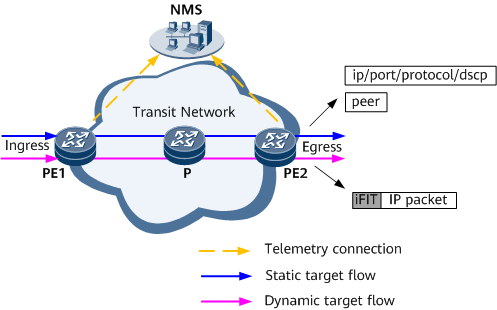Overview of iFIT
In-situ Flow Information Telemetry (iFIT) determines network performance by measuring the packet loss and latency of service packets transmitted on an IP network. This feature is easy to deploy and provides an accurate assessment of network performance.
Background
Currently, OAM performance measurement can be classified into out-of-band measurement and in-band measurement by measurement type. Out-of-band measurement includes NQA and TWAMP, and in-band measurement includes IP FPM. These methods have the following advantages and disadvantages:
- NQA can monitor the performance of multiple protocols running on networks. However, it monitors the performance of simulated packets (it constructs packets based on the types of measurement instances) rather than actual service packets transmitted on networks. The performance indicators collected by NQA may not represent the actual service quality, and therefore cannot serve as a solid reference for network performance analysis.
- TWAMP can insert probe packets into service flows, achieving fast and flexible deployment. However, to perform measurement, it uses packets sent at intervals. This produces low-precision measurement results and does not support hop-by-hop measurement.
- IP FPM is an in-band measurement method, but it has high requirements on network devices, applies to limited scenarios, and is complex to deploy.
The OAM detection technologies currently available cannot meet requirements on 5G transport networks. Huawei therefore launches the iFIT performance measurement solution. In terms of performance monitoring, iFIT meets the requirements of 5G transport networks and has the following characteristics:
- Scalability: iFIT has high detection precision, is easy to deploy, and can be expanded to meet future requirements.
- Fast fault diagnosis: iFIT provides in-band detection to measure the latency and packet loss of service flows in real time.
- Visualization: Performance data is displayed on a graphical user interface (GUI).

After iFIT is configured, packet forwarding performance may deteriorate.
iFIT Statistical Process
As shown in Figure 1, the iFIT statistical model is composed of three objects: target flows, the transit network, and the measurement system.
-
Target flows are key elements in iFIT statistics. A target flow must be specified before each statistics collection operation. Target flows can be classified as static or dynamic flows based on the generation mode.
- Static flows can be generated in different modes based on the measurement granularity.
- Based on the measurement granularity of 5-tuple, you can specify the related field information, including the 5-tuple (source IP address, destination IP address, protocol number, source port number, and destination port number) and differentiated services code point (DSCP), in an IP packet header to specify static flows. This method can be used to implement performance measurement for specific flows.
- Based on the measurement granularity of the peer IP/peer locator, you can specify a peer IPv4 or IPv6 address to generate a flow. This method can be used to implement performance measurement for E2E traffic.
- iFIT supports automatic learning for dynamic flows on the ingress based on mask matching or exact matching of source/destination addresses. In addition, with iFIT, you can flexibly monitor service quality in real time by configuring a whitelist. The dynamic flows on the transit nodes and the egress are triggered by the traffic with the iFIT header. If the dynamic flow instance does not collect traffic statistics for a long time, it automatically ages.

The default aging time of a dynamic flow instance is 10 times the measurement period, but cannot be less than 10 minutes.
- Static flows can be generated in different modes based on the measurement granularity.
-
The transit network only bears target flows. The target flows are not generated or terminated on the transit network. Each node on the transit network must be reachable at the network layer. The transit network can carry different types of services and tunnels. Table 1 lists the measurement scenarios that support iFIT.
Table 1 Measurement scenarios that support iFIT Service Type
Tunnel Type
Measurement Granularity
L3VPNv4/EVPN L3VPNv4 (HVPN)
MPLS (TE/LDP/BGP LSP/SR-MPLS BE/SR-MPLS TE/SR-MPLS TE Policy)
Measurement based on 5-tuple and DSCP or based on peer IP
SRv6 (SRv6 BE/SRv6 TE Policy)
Measurement based on 5-tuple and DSCP or based on peer locator
L3VPNv6/EVPN L3VPNv6 (HVPN)
MPLS (TE/LDP/BGP LSP/SR-MPLS BE/SR-MPLS TE/SR-MPLS TE Policy)
Measurement based on 5-tuple and DSCP or based on peer IP
L3VPNv6/EVPN L3VPNv6 (HVPN)
SRv6 (SRv6 BE/SRv6 TE Policy)
Measurement based on 5-tuple and DSCP or based on peer locator
EVPN VPWS
MPLS (TE/LDP/BGP LSP/SR-MPLS BE/SR-MPLS TE/SR-MPLS TE Policy)
Measurement based on peer IP
SRv6 (SRv6 BE/SRv6 TE Policy)
Measurement based on peer locator
IPv4 public network
SRv6 (SRv6 BE/SRv6 TE Policy)
Measurement based on 5-tuple and DSCP or based on peer locator
IPv6 public network
SRv6 (SRv6 BE/SRv6 TE Policy)
Measurement based on 5-tuple and DSCP or based on peer locator

The measurement granularities are applicable only to static flow measurement. Dynamic flow measurement is implemented regardless of measurement granularities and is applicable to all the preceding measurement scenarios.
- Measurement systemThe measurement system consists of the ingress (configured with iFIT and iFIT parameters) and multiple iFIT-capable devices. iFIT supports the following two metrics:
- Packet loss rate measurement: Within a measurement interval, the number of lost packets is the difference between the number of packets entering a transit network and the number of packets leaving the transit network.
- Delay measurement: Within a measurement interval, the delay is the time difference between a flow enters and leaves a network.
For details about the measurement indicators, see iFIT Measurement Metrics. The statistics result is sent to the NMS through telemetry for visualized display.
Statistics Collection Mode
- End-to-end measurement: To monitor network performance in real time, configure end-to-end measurement.
- Hop-by-hop measurement: To diagnose faults, configure hop-by-hop measurement.
